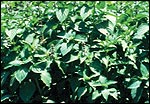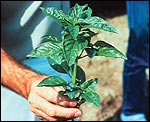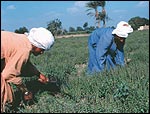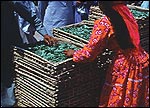Home | FOOD ARTICLES | Food Trivia | Today_in_Food_History | Food_History_Timeline | Recipes | Cooking_Tips | Food_Videos | Food_Quotes | Who’s_Who | Culinary_Schools_&_Tours | Food_Trivia_Quizzes | Food_Poems | Free_Magazines | Food_Festivals_and_Events
Food Articles, News & Features Section
FREE Magazines
and other Publications
Free Professional and Technical Research, White Papers, Case Studies, Magazines, and eBooks
BASIL: EGYPTIAN FIELD REPORT
See also: Basil Facts; Basil, Saint or Sinner; Basil Trivia; Basil Cooking Tips
Spice Buyer's Journal: Egypt
I’m Al Goetze, chief spice buyer at McCormick, reporting this installment of the Spice Buyer’s Journal from the lower Nile River Valley in Egypt, where some of the best agriculture in the world takes place.
When people think of Egypt, they most often think of the desert, and rightly so. Ninety-five percent of the country is made up of the Eastern Sahara. Because of this, many people do not realize that, in fact, Egypt is a premier source of the world’s basil. Here is a look inside this year’s harvest.

Inspecting the Fields
After arriving in Cairo and driving three hours south and southwest, I’ve spent the past two days inspecting two key growing areas, Beni Suef and El Fayoum. The weather is perfect — sunny, very hot and humid — and it is clear at first sight that these conditions, along with the fertile soil and abundant water supply, have produced a robust crop.
The Nile River Valley is very narrow here — about five to 10 miles wide. The river is truly the lifeblood of the area, which is comprised of small family farms that grow multiple crops. In addition to basil, one might see fields of marjoram, corn, tomatoes, and onions.

As I walk through the field, the aroma of the basil leaves is absolutely intoxicating. Basil’s scent is so fresh and clean that it is easy to see how people in ancient times found it captivating. The sunlight warms the lush green fields, which are bordered by date and palm trees, and creates an amazing contrast against the desert backdrop.
Each year, in late February and early March, basil (Ocimum basilicum), a member of the mint family, is cultivated from seeds in nurseries. Seedlings are transferred to the fields in April, and the harvest begins in early July.
Here, all basil is carefully reaped by hand, using a serrated-edge sickle, to avoid bruising the delicate leaves. After the initial cuttings are taken, new growth is harvested approximately every 20 days until mid-September. Each subsequent cut renders the plant bushier and more fruitful. Once harvested, the basil is placed carefully in baskets and sun dried to keep its bright green color.

El Sayed, one of the growers, comes from a long line of farmers. Smiling, he tells me he is certain that his ancestors supplied farm rations to the workers building the Pharaohs pyramids just up the road in Saggara and Giza.

A Modern Flavor Deeply Rooted in History
Basil is believed to have originated in India, where it still grows wild today. I recently came upon it growing between rows of chile plants during a trip to Tamil Nadu, in Southern India. One farmer there told me that every good Indian homemaker has a potted basil plant growing just outside the kitchen door.
Basil later found its way to Egypt, where it became part of the embalming and mummification process. In addition, ancient Romans regarded basil as a symbol of love and fertility. Through the centuries, it became customary for young Italian suitors to wear a sprig of basil as an indication of their marital intentions.
As I head back to Cairo, along the road that goes out to the desert edge and climbs above the valley, it is quite a sight to see the late day sunlight against the lush green fields and palm trees. I find myself thinking about how people will savor this harvest in their meals.
Since Basil is such a versatile herb, it can be used in a wide array of Mediterranean dishes.
About McCormick
McCormick was founded in 1889 in Baltimore, Md. Today it is the largest spice company in the world. McCormick sources only the finest ingredients from around the globe to bring the highest quality flavors to consumers. For more information, visit McCormick online at www.mccormick.com, or call 1-800-MEAL-TIP (1-800-632-5847).
RELATED ARTICLES
Please feel free to link to any pages of FoodReference.com from your website.
For permission to use any of this content please E-mail: james@foodreference.com
All contents are copyright © 1990 - 2025 James T. Ehler and www.FoodReference.com unless otherwise noted. All rights reserved.
You may copy and use portions of this website for non-commercial, personal use only.
Any other use of these materials without prior written authorization is not very nice and violates the copyright.
Please take the time to request permission.

